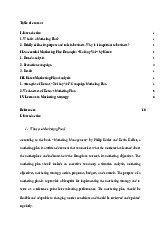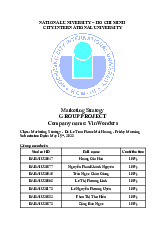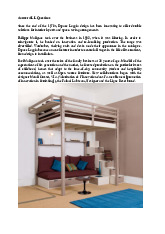



















Preview text:
1-100
1. When entering a new market, a company should consider which of the following to minimize risk? A) Direct investment B) Licensing C) Joint ventures D) Franchising
2. Which strategy involves introducing new products to existing markets to achieve growth? A) Market penetration B) Market development C) Product development D) Diversification
3. A potential drawback of a market penetration strategy is:
A) High costs of product development B) Market saturation
C) Increased risk in new markets D) Complex supply chains
4. In a mature market, a company should focus on: A) Aggressive price cuts to gain market share
B) Diversifying into unrelated industries
C) Enhancing product features to differentiate from competitors
D) Reducing marketing expenditure
5. Which strategy is often used to maximize cash flow from declining products? (loop) A) Divestiture B) Harvesting C) Market expansion D) Product innovation
6. Successful strategy implementation requires an organization to:
A) Adhere strictly to the initial strategic plan
B) Be flexible and responsive to changes
C) Limit employee involvement to senior management
D) Avoid revising the strategy once implemented
7. The balanced scorecard approach integrates which of the following perspectives?
A) Financial, customer, internal process, and learning & growth
B) Financial, marketing, operations, and legal
C) Product, market, finance, and technology
D) Customer, competition, cost, and compliance
8. Which factor is least likely to influence the successful implementation of a marketing strategy? A) Organizational culture B) Competitor actions C) Technological advancements D) Seasonal changes in demand
9. What is a primary benefit of using a cross-functional team in strategy implementation?
A) Reduced implementation time
B) Increased innovation and diverse perspectives
C) Simplified decision-making processes
D) Decreased need for communication
10. A company can effectively monitor its strategy implementation by:
A) Conducting annual reviews only
B) Establishing regular feedback loops
C) Ignoring short-term deviations from the plan
D) Relying solely on financial metrics
11. What is the primary purpose of conducting a PEST analysis? (loop)
A) Identifying internal strengths and weaknesses
B) Assessing the external macro-environmental factors
C) Evaluating competitors' market positions
D) Analyzing product life cycle stages
12. Porter's Five Forces framework helps in analyzing: (loop)
A) The internal capabilities of an organization
B) The competitive intensity and attractiveness of a market
C) The macroeconomic environment
D) The financial health of a company
13. Which tool is specifically designed to understand a company’s competitive positionwithin its industry? A) SWOT analysis B) PEST analysis C) BCG matrix D) Porter's Five Forces
14. A primary risk of a diversification strategy is: A) Overextending resources B) Market saturation C) Brand dilution D) Increased competition
15. Effective marketing research should: A) Confirm long-held company beliefs
B) Focus solely on existing customers
C) Be used to inform and guide marketing strategies
D) Be conducted internally without external sources
16. Market segmentation is vital because:
A) It allows for mass marketing strategies to be more effective
B) It helps in designing products that appeal to everyone
C) It enables targeted marketing strategies for specific customer groupsD) It
ensures the product development process is longer and more complex
17. Identifying Market Segments and Target Customers is crucial for: A) Maintaining status quo
B) Adapting business strategies C) Reducing customer focus
D) Ignoring competitor actions
18. The primary risk of being a first mover is: A) High market share B) Brand loyalty C) Market uncertainty D) Lower production costs
19. Which factor influences consumer behavior the most? A) Cultural factors B) Personal success C) Technological advances D) Economic conditions
20. Glocalization refers to: A) Ignoring local differences
B) Global brands not operating locally
C) Adapting global products to local markets
D) Standardizing products across all markets
21. Business markets are characterized by: A) Emotional buying decisions
B) Deriving demand from consumer markets
C) Smaller, more focused target markets
D) Less complex buying processes
22. The least risky strategy for entering a new market is: A) Franchising B) Direct investment C) Exporting D) Forming joint ventures
23. In a growth market, a key strategy is: A) Diversification B) Market penetration C) Product development D) Market development
24. A company should ______ in a declining market.A) Invest heavily in new product development
B) Focus on market penetration strategies
C) Consider divestiture or harvesting
D) Expand the target market aggressively
25. Implementation of marketing strategies often requires:
A) Rigidity in strategy execution B) No feedback mechanisms
C) Adaptability and responsiveness
D) Ignoring competitor actions
26. The purpose of a market analysis is to:
A) Focus solely on internal company operations
B) Understand the competitive landscape
C) Determine the company's stock value
D) Simplify product development processes
27. Which strategy is often used to maximize cash flow from declining products? (loop) A) Divestiture B) Harvesting C) Market expansion D) Product innovation
28. Marketing Planning and Management is essential for: A) Reducing employee turnover
B) Setting and achieving long-term business goals
C) Decreasing the importance of customer service
D) Limiting the company's product range
29. Business markets differ from Consumer Markets because:
A) The buying process is more informal
B) Purchases are more frequent but with lower volume
C) The buying decision is often based on personal relationships
D) There are fewer buyers but with larger purchases
30. The essence of Blue Ocean Strategy is to: A) Increase competition in existing markets
B) Find and develop uncontested market spaces
C) Focus on product differentiation only
D) Cut prices to win customers
31. Glocal Strategy of Global Brands suggests: A) Avoiding adaptation to local preferences
B) A standardized approach to marketing worldwide
C) Tailoring products and marketing to local markets
D) Focusing only on global trends and ignoring local differences
32. Conducting Marketing Research is crucial for:
A) Maintaining a company's current product portfolio without change
B) Understanding market needs and driving innovation
C) Ensuring the CEO's personal preferences are met
D) Reducing the overall marketing budget
33. Which factor is least likely to influence the successful implementation of a marketingstrategy? (loop) A) Organizational culture B) Competitor actions C) Technological advancements D) Seasonal changes in demand
34. A primary benefit of using a cross-functional team in strategy implementation is: (loop)
A) Reduced implementation time
B) Increased innovation and diverse perspectives
C) Simplified decision-making processes
D) Decreased need for communication
35. The balanced scorecard approach integrates which of the following perspectives?(loop)
A) Financial, customer, internal process, and learning & growth
B) Financial, marketing, operations, and legal
C) Product, market, finance, and technology
D) Customer, competition, cost, and compliance
36. What is the primary purpose of conducting a PEST analysis? (loop)
A) Identifying internal strengths and weaknesses
B) Assessing the external macro-environmental factors
C) Evaluating competitors' market positions
D) Analyzing product life cycle stages
37. Porter's Five Forces framework helps in analyzing: (loop)
A) The internal capabilities of an organization
B) The competitive intensity and attractiveness of a market
C) The macroeconomic environment
D) The financial health of a company
38. Which tool is specifically designed to understand a company’s competitive
positionwithin its industry? (loop) A) SWOT analysis B) PEST analysis C) BCG matrix D) Porter's Five Forces
39. A major advantage of the BCG matrix is:
A) It simplifies the decision-making process by categorizing products into four quadrants
B) It provides detailed financial metrics for each product
C) It focuses solely on market growth rate
D) It ignores the competitive landscape
40. The primary goal of Blue Ocean Strategy is to:
A) Outcompete existing competitors in a saturated market
B) Create new demand in an uncontested market space
C) Focus on incremental improvements to existing products
D) Reduce costs by cutting down on marketing expenses
41. Which of the following best describes a core competency?A) A minor skill that is
easily replicated by competitors
B) A unique strength that gives a company a competitive advantage
C) A standard industry practice D) A temporary market trend
42. Which of the following is a key characteristic of a successful differentiation strategy? A) Low-cost production B) Unique product features C) Broad market appeal D) Minimal marketing effort
43. In which stage of the product life cycle is marketing focused on building
brandpreference and increasing market share? A) Introduction B) Growth C) Maturity D) Decline
44. What is the primary focus of a market development strategy?
A) Introducing new products to the current market
B) Expanding into new markets with existing products
C) Enhancing product features for current customers D) Reducing production costs
45. Which of the following is an example of a defensive strategy? A) Entering a new market B) Improving product quality
C) Reducing prices to fend off competitors
D) Launching a new marketing campaign
46. Which type of market segmentation divides the market based on lifestyle, personality,and values? A) Demographic B) Geographic C) Psychographic D) Behavioral
47. Which of the following best describes the concept of customer lifetime value (CLV)?
A) The total revenue a company expects from a customer over the entire duration of their relationship
B) The average amount spent by a customer per transaction
C) The cost of acquiring a new customer
D) The profit margin on a single sale
48. A successful cost leadership strategy primarily focuses on:
A) Offering unique product features
B) Reducing production and operational costs
C) Providing exceptional customer service D) Entering new markets
49. Which of the following is a benefit of a focused differentiation strategy? A) Broad market appeal B) High economies of scale
C) Strong customer loyalty within a niche market D) Low marketing costs
50. In which stage of the product life cycle does a company typically see declining salesand profits? A) Introduction B) Growth C) Maturity D) Decline
51. The Ansoff Matrix is used to:
A) Identify internal strengths and weaknesses
B) Analyze competitive forces within an industry
C) Develop strategies for market and product growth
D) Evaluate the financial health of a company
52. Which of the following is a characteristic of a monopolistic competition marketstructure?
A) Few sellers with homogeneous products
B) Many sellers with differentiated products C) One dominant seller D) High barriers to entry
53. Which of the following is an example of backward integration?
A) A retailer opening its own manufacturing facility
B) A manufacturer opening its own retail stores
C) A company outsourcing its production to a third-party
D) A firm entering a new geographic market
54. In which type of market structure is a company most likely to engage in non- pricecompetition? A) Perfect competition B) Oligopoly C) Monopoly D) Monopolistic competition
55. Which of the following strategies is focused on creating products or services that
havea significant positive impact on society? A) Cost leadership B) Differentiation
C) Corporate social responsibility (CSR) D) Market penetration
56. A SWOT analysis helps a company to:
A) Identify external opportunities and threats
B) Assess internal strengths and weaknesses
C) Evaluate market growth and share D) Both A and B
57. In the BCG matrix, "Question Marks" are characterized by:
A) High market share and high market growth
B) Low market share and high market growth
C) High market share and low market growth
D) Low market share and low market growth
58. The term "economies of scale" refers to:
A) The increase in costs per unit as production volume increases
B) The decrease in costs per unit as production volume increases
C) The ability to charge higher prices due to brand strength
D) The benefits of diversifying into multiple markets
59. A company pursuing a market skimming pricing strategy is likely to: (loop)
A) Set a low initial price to gain market share quickly
B) Set a high initial price and lower it over time C) Match competitor pricing
D) Set a price below the cost of production
60. The primary goal of a differentiation strategy is to: (loop)
A) Achieve the lowest cost of production
B) Offer products or services with unique attributes valued by customers
C) Enter as many markets as possible
D) Focus on a narrow market segment
61. Which of the following best describes a market penetration strategy?
A) Introducing new products to existing markets
B) Entering new markets with existing products
C) Increasing market share for existing products in existing markets
D) Expanding into new geographic regions
62. A key challenge in implementing a market development strategy is:
A) Identifying new markets for existing products
B) Developing new products for existing markets
C) Maintaining product quality while reducing costs
D) Ensuring customer loyalty in new markets
63. Which of the following is an example of a behavioral segmentation variable? (loop) A) Age B) Lifestyle C) Purchase frequency D) Income
64. Which pricing strategy involves setting a high initial price and then graduallylowering it over time? A) Market penetration B) Market skimming C) Competitive pricing D) Cost-plus pricing
65. The primary advantage of direct distribution channels is: A) Reduced distribution costs
B) Greater control over the marketing process C) Increased market reach
D) Improved customer relationships
66. Which of the following is a key characteristic of a product differentiation strategy? A) Low production costs B) Unique product features C) High market share D) Standardized products
67. In a highly competitive market, a focus strategy is most effective when:
A) The target market is large and diverse
B) The target market is small and well-defined
C) The company has high production capacity
D) The company has low production costs
68. Which of the following best describes the concept of "brand equity"? (loop)
A) The financial value of a brand
B) The physical assets owned by a brand
C) The market share held by a brand
D) The loyalty and perceptions associated with a brand
69. Which of the following is an example of a push promotional strategy? (loop)
A) Advertising directly to consumers
B) Offering trade promotions to retailers
C) Utilizing social media influencers
D) Implementing a customer loyalty program
70. A company using a cost-plus pricing strategy determines prices by:
A) Analyzing competitor prices
B) Adding a markup to the cost of production
C) Assessing customer willingness to pay
D) Matching industry average prices
71. Which of the following is a key benefit of using a CRM system? (loop)
A) Reducing product development time
B) Enhancing customer relationships
C) Increasing production efficiency
D) Lowering distribution costs
Which type of advertising focuses on building long-term brand recognition and loyalty? 72. A) B) Persuasive advertising C) Reminder advertising D) Comparative advertising 73.
The primary goal of relationship marketing is to: (loop) A) Increase short-term sales
B) Build long-term relationships with customers C) Expand into new markets
D) Diversify the product portfolio 74.
Which of the following best describes a joint venture? (loop)
A) A company acquiring another company
B) Two companies forming a new, jointly owned business
C) A company licensing its technology to another company
D) A company franchising its business model 75.
The term "value proposition" refers to:(loop)
A) The cost structure of a company
B) The unique value a product or service provides to customers
C) The market share of a company
D) The pricing strategy of a company 76.
In which stage of the product life cycle are sales typically at their highest? A) Introduction B) Growth C) Maturity D) Decline 77.
Which of the following is a primary disadvantage of using a penetration pricingstrategy?
A) It may lead to initial losses
B) It discourages competitors from entering the market
C) It is difficult to implement
D) It attracts a large number of customers quickly 78.
A primary characteristic of a niche market is: A) Broad market appeal B) High competition C) Specialized customer needs D) Low profitability 79.
Which of the following is a benefit of a well-developed brand? A) Lower marketing costs B) Higher price sensitivity C) Reduced customer loyalty
D) Increased bargaining power with suppliers 80.
Which of the following strategies involves focusing on a specific group of
consumerswithin a broader market? A) Mass marketing B) Niche marketing C) Differentiated marketing D) Undifferentiated marketing 81.
Which of the following is an example of a company using a market developmentstrategy? (loop)
A) Launching a new product line in the existing market
B) Entering a new geographic market with existing products
C) Improving product features to increase sales
D) Reducing production costs to lower prices 82.
The concept of "product cannibalization" refers to:
A) A new product taking sales away from an existing product
B) A product becoming obsolete due to new technology
C) A product failing to meet sales targets
D) A company discontinuing an unprofitable product 83.
Which of the following best describes a "pull" promotional strategy? (loop)
A) Encouraging intermediaries to push products to consumers
B) Using advertising to create consumer demand
C) Offering discounts to retailers
D) Implementing trade promotions 84.
Which of the following is a characteristic of a growth market? A) Declining sales B) High levels of competition C) Slow market expansion D) Decreasing customer base 85.
Which of the following is an example of a company using a diversification strategy? (loop)
A) Entering a new market with an existing product
B) Developing new products for new markets
C) Increasing market share in the existing market
D) Improving existing product features 86.
A key benefit of digital marketing over traditional marketing is: A) Higher production costs B) Limited reach
C) Greater ability to measure results
D) Less engagement with customers 87.
Which of the following best describes a company's "mission statement"? (loop)
A) A declaration of the company's core purpose and focus
B) A financial forecast for the next fiscal year
C) A detailed plan for marketing activities
D) A list of products and services offered 88.
Which of the following is a characteristic of a monopoly market structure? (loop)
A) Many sellers with differentiated products
B) One seller with significant market power C) Low barriers to entry D) High levels of competition 89.
The primary focus of content marketing is to: (loop)
A) Directly sell products to customers
B) Create valuable and relevant content to attract and engage a target audience
C) Increase short-term sales through promotions D) Develop new product lines 90.
Which of the following is an example of a company using a price skimming strategy?
A) Setting a high initial price for a new product and then lowering it over time
B) Setting a low initial price to gain market share quickly C) Matching competitor prices
D) Setting prices based on production costs 91.
Which of the following best describes a market niche strategy? (loop)
A) Targeting a large, broad market
B) Targeting a small, well-defined segment of the market
C) Offering the lowest prices in the market
D) Offering a wide range of products 92.
Which of the following is a primary advantage of a franchise business model? (loop) A) Lower startup costs
B) Established brand recognition and support
C) Complete operational freedom
D) High profit margins from the start 93.
The term "value chain" refers to: (loop)
A) The network of suppliers and partners that a company works with
B) The sequence of activities that add value to a product or service
C) The total value of a company's assets
D) The process of setting product prices 94.
A major benefit of using digital marketing is: (loop) A) Higher advertising costs B) Limited audience reach
C) Ability to track and measure campaign performance
D) Slower response time from consumers 95.
Which of the following is a key component of a company's marketing mix? A) Market segmentation B) SWOT analysis C) Product positioning D) Pricing strategy 96.
A company that focuses on minimizing costs and offering low prices is
likelypursuing which strategy? (loop)
A) DifferentiationB) Cost leadership C) Focus D) Diversification 97.
Which of the following is an example of a psychographic segmentation variable? A) Age B) Income C) Personality D) Geographic location 98.
The primary objective of public relations is to: A) Increase short-term sales
B) Build and maintain a positive public image C) Reduce production costs




